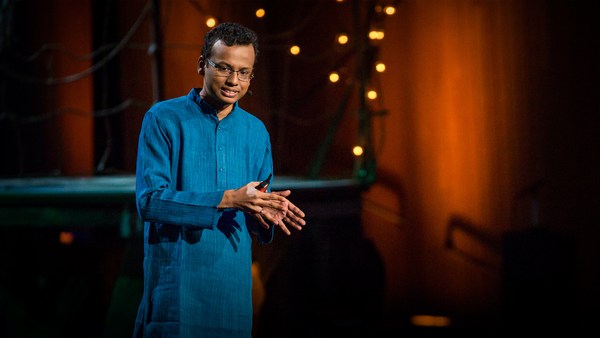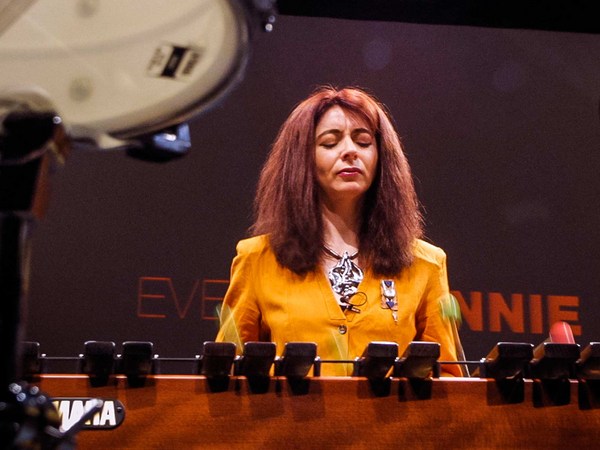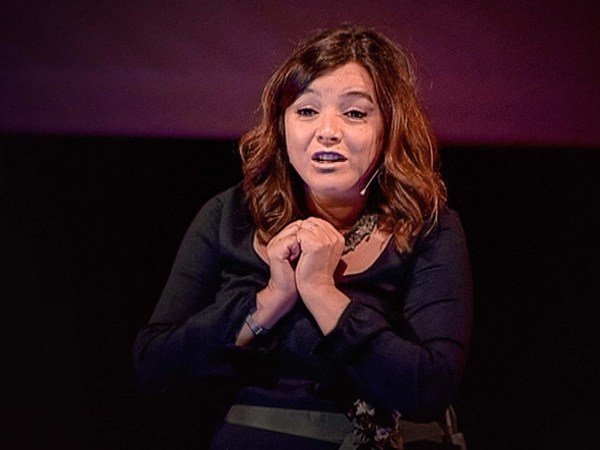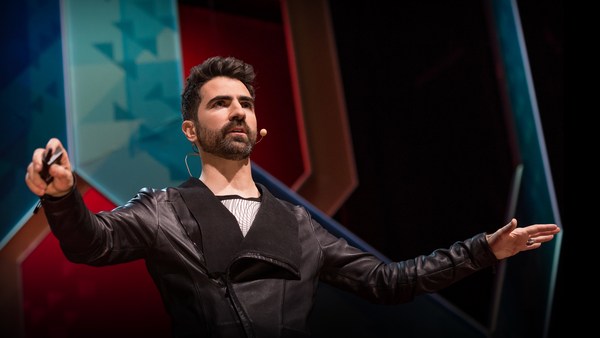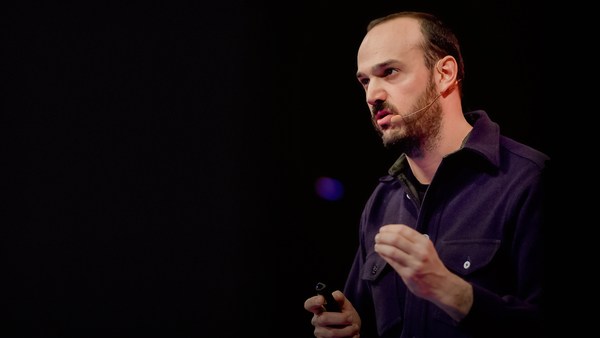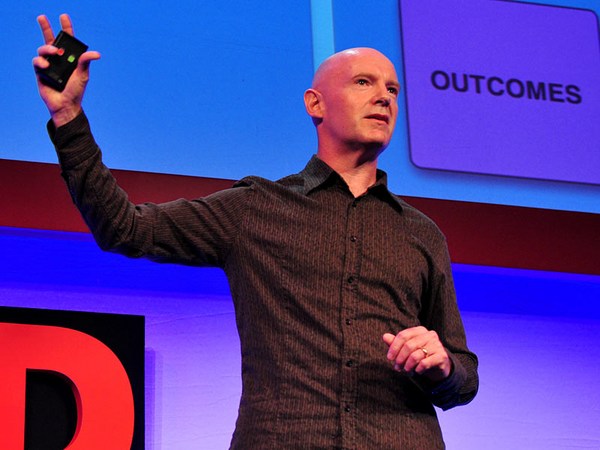Interpreter: Piano, "p," is my favorite musical symbol. It means to play softly. If you're playing a musical instrument and you notice a "p" in the score, you need to play softer. Two p's -- even softer. Four p's -- extremely soft. This is my drawing of a p-tree, which demonstrates no matter how many thousands upon thousands of p's there may be, you'll never reach complete silence. That's my current definition of silence: a very obscure sound.
I'd like to share a little bit about the history of American Sign Language, ASL, plus a bit of my own background. French sign language was brought to America during the early 1800s, and as time went by, mixed with local signs, it evolved into the language we know today as ASL. So it has a history of about 200 years.
I was born deaf, and I was taught to believe that sound wasn't a part of my life. And I believed it to be true. Yet, I realize now that that wasn't the case at all. Sound was very much a part of my life, really, on my mind every day. As a Deaf person living in a world of sound, it's as if I was living in a foreign country, blindly following its rules, customs, behaviors and norms without ever questioning them.
So how is it that I understand sound? Well, I watch how people behave and respond to sound. You people are like my loudspeakers, and amplify sound. I learn and mirror that behavior. At the same time, I've learned that I create sound, and I've seen how people respond to me. Thus I've learned, for example ... "Don't slam the door!" "Don't make too much noise when you're eating from the potato-chip bag!"
(Laughter)
"Don't burp, and when you're eating, make sure you don't scrape your utensils on the plate." All of these things I term "sound etiquette." Maybe I think about sound etiquette more than the average hearing person does. I'm hyper-vigilant around sound. And I'm always waiting in eager nervous anticipation around sound, about what's to come next.
Hence, this drawing. TBD, to be decided. TBC, to be continued. TBA, to be announced. And you notice the staff -- there are no notes contained in the lines. That's because the lines already contain sound through the subtle smudges and smears.
In Deaf culture, movement is equivalent to sound. This is a sign for "staff" in ASL. A typical staff contains five lines. Yet for me, signing it with my thumb sticking up like that doesn't feel natural. That's why you'll notice in my drawings, I stick to four lines on paper.
In the year 2008, I had the opportunity to travel to Berlin, Germany, for an artist residency there. Prior to this time, I had been working as a painter. During this summer, I visited different museums and gallery spaces, and as I went from one place to the next, I noticed there was no visual art there. At that time, sound was trending, and this struck me ... there was no visual art, everything was auditory.
Now sound has come into my art territory. Is it going to further distance me from art? I realized that doesn't have to be the case at all. I actually know sound. I know it so well that it doesn't have to be something just experienced through the ears. It could be felt tactually, or experienced as a visual, or even as an idea.
So I decided to reclaim ownership of sound and to put it into my art practice. And everything that I had been taught regarding sound, I decided to do away with and unlearn. I started creating a new body of work. And when I presented this to the art community, I was blown away with the amount of support and attention I received. I realized: sound is like money, power, control -- social currency. In the back of my mind, I've always felt that sound was your thing, a hearing person's thing. And sound is so powerful that it could either disempower me and my artwork, or it could empower me. I chose to be empowered.
There's a massive culture around spoken language. And just because I don't use my literal voice to communicate, in society's eyes it's as if I don't have a voice at all. So I need to work with individuals who can support me as an equal and become my voice. And that way, I'm able to maintain relevancy in society today.
So at school, at work and institutions, I work with many different ASL interpreters. And their voice becomes my voice and identity. They help me to be heard. And their voices hold value and currency. Ironically, by borrowing out their voices, I'm able to maintain a temporary form of currency, kind of like taking out a loan with a very high interest rate. If I didn't continue this practice, I feel that I could just fade off into oblivion and not maintain any form of social currency.
So with sound as my new art medium, I delved into the world of music. And I was surprised to see the similarities between music and ASL. For example, a musical note cannot be fully captured and expressed on paper. And the same holds true for a concept in ASL. They're both highly spatial and highly inflected -- meaning that subtle changes can affect the entire meaning of both signs and sounds.
I'd like to share with you a piano metaphor, to have you have a better understanding of how ASL works. So, envision a piano. ASL is broken down into many different grammatical parameters. If you assign a different parameter to each finger as you play the piano -- such as facial expression, body movement, speed, hand shape and so on, as you play the piano -- English is a linear language, as if one key is being pressed at a time. However, ASL is more like a chord -- all 10 fingers need to come down simultaneously to express a clear concept or idea in ASL. If just one of those keys were to change the chord, it would create a completely different meaning. The same applies to music in regards to pitch, tone and volume. In ASL, by playing around with these different grammatical parameters, you can express different ideas.
For example, take the sign TO-LOOK-AT. This is the sign TO-LOOK-AT. I'm looking at you. Staring at you.
(Laughter)
(Laughter)
Oh -- busted.
(Laughter)
Uh-oh. What are you looking at? Aw, stop.
(Laughter)
I then started thinking, "What if I was to look at ASL through a musical lens?" If I was to create a sign and repeat it over and over, it could become like a piece of visual music. For example, this is the sign for "day," as the sun rises and sets. This is "all day." If I was to repeat it and slow it down, visually it looks like a piece of music. All ... day. I feel the same holds true for "all night." "All night." This is ALL-NIGHT, represented in this drawing. And this led me to thinking about three different kinds of nights: "last night," "overnight," (Sings) "all night long."
(Laughter)
I feel like the third one has a lot more musicality than the other two.
(Laughter)
This represents how time is expressed in ASL and how the distance from your body can express the changes in time. For example, 1H is one hand, 2H is two hand, present tense happens closest and in front of the body, future is in front of the body and the past is to your back. So, the first example is "a long time ago." Then "past," "used to" and the last one, which is my favorite, with the very romantic and dramatic notion to it, "once upon a time."
(Laughter)
"Common time" is a musical term with a specific time signature of four beats per measure. Yet when I see the word "common time," what automatically comes to mind for me is "at the same time." So notice RH: right hand, LH: left hand. We have the staff across the head and the chest.
[Head: RH, Flash claw]
[Common time]
[Chest: LH, Flash claw]
I'm now going to demonstrate a hand shape called the "flash claw." Can you please follow along with me? Everybody, hands up. Now we're going to do it in both the head and the chest, kind of like "common time" or at the same time. Yes, got it. That means "to fall in love" in International [Sign].
(Laughter)
International [Sign], as a note, is a visual tool to help communicate across cultures and sign languages around the world.
The second one I'd like to demonstrate is this -- please follow along with me again. And now this. This is "colonization" in ASL.
(Laughter)
Now the third -- please follow along again. And again. This is "enlightenment" in ASL. So let's do all three together. "Fall in love," "colonization" and "enlightenment." Good job, everyone.
(Laughter)
Notice how all three signs are very similar, they all happen at the head and the chest, but they convey quite different meanings.
So it's amazing to see how ASL is alive and thriving, just like music is. However, in this day and age, we live in a very audio-centric world. And just because ASL has no sound to it, it automatically holds no social currency. We need to start thinking harder about what defines social currency and allow ASL to develop its own form of currency -- without sound. And this could possibly be a step to lead to a more inclusive society. And maybe people will understand that you don't need to be deaf to learn ASL, nor do you have to be hearing to learn music.
ASL is such a rich treasure that I'd like you to have the same experience. And I'd like to invite you to open your ears, to open your eyes, take part in our culture and experience our visual language. And you never know, you might just fall in love with us.
(Applause)
Thank you.
Denise Kahler-Braaten: Hey, that's me.
(Applause)
